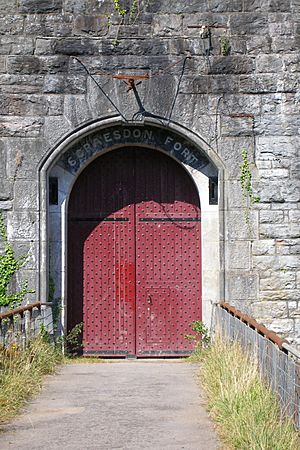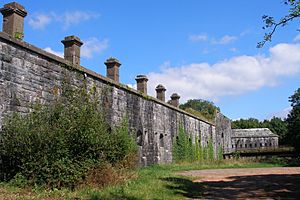Scraesdon Fort facts for kids
Scraesdon Fort is a large old fort near Antony, Cornwall. It is one of many forts built around Plymouth in Cornwall. These forts were made to protect Plymouth Sound and the important naval base at Devonport.
The forts were built because of a worry that France might attack naval bases in southern England. A leader named Lord Palmerston decided to build them.
Contents
Building a Strong Fort
Scraesdon Fort was designed in 1859. Captain William Crossman created the plans for the fort. A company from Plymouth called F Roach and Company built it.
How the Fort Was Built
The fort cost a lot of money to build, about £137,000. It was made in a special shape, almost like an octagon. It has a dry ditch around it for defense.
Guns and Defenses
The fort was planned to have twenty-seven large guns on its walls. By 1893, it had different types of guns. These included a 64-Pounder gun and several 7-inch guns. It also had some 32-Pounder and 5-inch guns.
The highest part of the fort is 254 feet above sea level. The lower part is 173 feet above sea level.
What is Scraesdon Fort Used For Now?
The Ministry of Defence (MOD) used the fort for training soldiers. Today, it is empty and a bit run down. It is also overgrown with plants.
Training and Activities
In the past, the Royal Navy used the fort to train apprentices. These were young people learning to be engineers. Now, Royal Marine Commandos sometimes use it for their final training exercises. Local Army Reserve groups also train there. Sometimes, people even use the fort for airsoft games.
Scraesdon Fort was made a Grade II listed building in 1968. This means it is an important historical building.
The Fort's Own Railway
The fort once had its own military railway. This railway connected the fort to the River Lynher at Wacker Quay. It also linked Scraesdon Fort to Fort Tregantle.
The railway ran under a metal bridge and then under the A374 road. You can still see parts of the old railway today. There was also a large area next to the east wall for sorting railway cars. The railway was used from 1893 to 1903.





